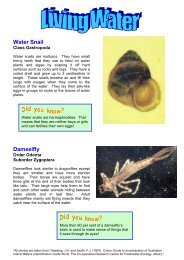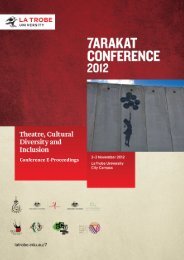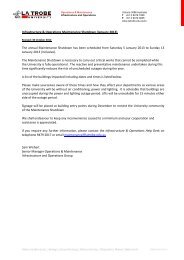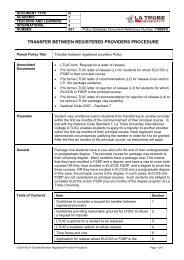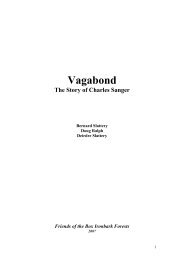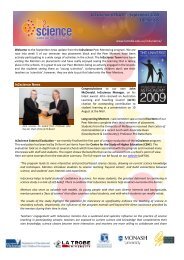Project Report - La Trobe University
Project Report - La Trobe University
Project Report - La Trobe University
Create successful ePaper yourself
Turn your PDF publications into a flip-book with our unique Google optimized e-Paper software.
Appendix 3. Manila Bulletin article<br />
They left their heart in Kalinga<br />
By Rachel C. Barawid<br />
First posted in the Thursday, July 16, 2009 edition of the Manila Bulletin (sourced online<br />
from: http://www.mb.com.ph/articles/211152/they-left-their-heart-kalinga)<br />
An indigenous community in Kalinga gets<br />
help from the most unlikely people -- at the<br />
right time.<br />
It all began with a grueling 22-hour<br />
backpacking adventure in the Cordilleras<br />
for Australian tourist Tim Andrews. His<br />
travels brought him to an indigenous<br />
village in Tinglayan, Kalinga province<br />
where he spent the night with one of the<br />
Ichananaw families.<br />
Fascinated with the place and its people,<br />
Andrews went back, this time with friend<br />
Edwyn Cameron. The discovery of this<br />
paradise also enticed Edwyn’s wife Maria<br />
to join them on yet another trip. The<br />
couple who stayed in the country on a<br />
study and professional volunteer<br />
program, found themselves smitten with<br />
the people and the rich culture.<br />
“It’s the friendships that came first, and<br />
then the partnership. The community was<br />
open, warm and hospitable,” shares 26year-old<br />
Maria from Melbourne.<br />
INDIGENIZING EDUCATION<br />
Maria then studied the local language, in<br />
the process endearing herself to the<br />
Ichananaw children and elders who asked<br />
for her help to preserve their culture.<br />
Some 6,700 members of the Ichananaw<br />
tribe live in the remote community in<br />
Barangay Dananao in Kalinga, accessible<br />
only via a three-hour hike. Farming is<br />
their source of livelihood.<br />
Indigenizing Education in a Kalinga Public School | 34<br />
“The elder Fargwog Aga-id, a teacher,<br />
asked us to stay for one year and help<br />
document their traditions to pass on to<br />
future generations. But we only had five<br />
months to spare so we compromised on<br />
getting it all done within that period,”<br />
recalls Maria, a research fellow at the<br />
Philippines Australia Studies Centre in <strong>La</strong><br />
<strong>Trobe</strong> <strong>University</strong> in Australia and a<br />
volunteer at the Ateneo Center for<br />
Educational<br />
Development (ACED).<br />
She was also approached by Arlene<br />
Dawing, principal of the Dananao<br />
Elementary School (DES) to help their<br />
school avail of educational materials<br />
through ACED. “We have only four<br />
teachers to cater to 160 pupils.<br />
We have seven classes but only five<br />
makeshift classrooms. We only have a few<br />
textbooks so the teachers are the ones<br />
holding the book and reading aloud to<br />
their students,” laments Dawing.<br />
She says most children only finish<br />
elementary. Those who go to high school<br />
and college support themselves by<br />
working as house helpers in nearby<br />
towns.<br />
Apart from having a poor quality of<br />
education due to a mismatch between the<br />
indigenous students’ way of life versus<br />
the teaching and learning tools available,<br />
the IPs cultural heritage is also in danger<br />
of becoming extinct. There is no<br />
comprehensive documentation of their


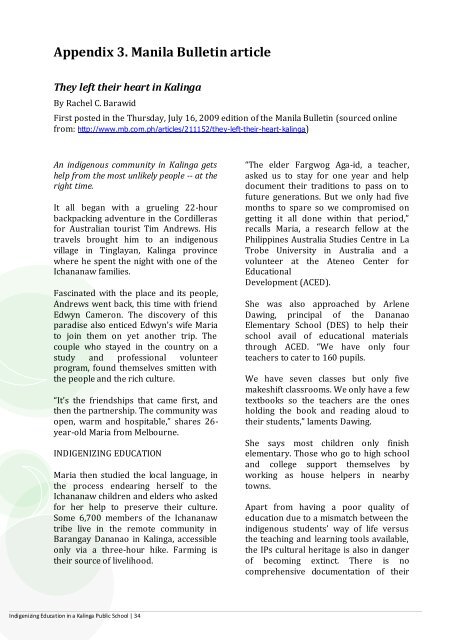
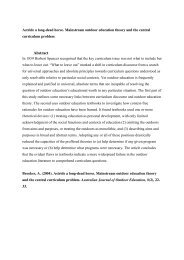
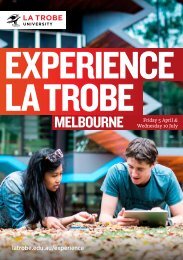
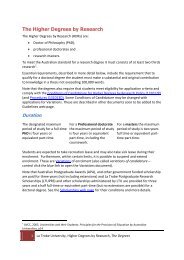
![Ottoman Empire course brochure [PDF 612KB] - La Trobe University](https://img.yumpu.com/12001562/1/184x260/ottoman-empire-course-brochure-pdf-612kb-la-trobe-university.jpg?quality=85)
![Getting Ready to Talk Manual [PDF 315KB] - La Trobe University](https://img.yumpu.com/11430807/1/190x245/getting-ready-to-talk-manual-pdf-315kb-la-trobe-university.jpg?quality=85)
